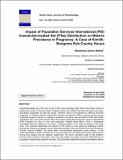| dc.contributor.author | Mukhwana Dennis Wafula | |
| dc.date.accessioned | 2022-02-03T08:56:23Z | |
| dc.date.available | 2022-02-03T08:56:23Z | |
| dc.date.issued | 2020 | |
| dc.identifier.uri | https://repository.maseno.ac.ke/handle/123456789/4855 | |
| dc.description | https://asianarchive.co.in/index.php/SAJP/article/view/24240 | en_US |
| dc.description.abstract | Insecticide-treated net (ITN) use is one of the most promising tools which have been shown to reduce the number of mosquito bites. Pregnant women and children less than five years have been specifically designated as high-risk groups, therefore need to be protected by effective personal protection. An intensive effort by Population Services International (PSI) to prevent malaria among vulnerable groups in Kenya by creating a mosquito ‘net culture’ was launched in 2002 sells highly subsidized nets. During the second half of the project (2004-2007) Population service international (PSI) increased its focus on the rural population. Despite these efforts, there is inadequate knowledge about the efficacy of net use in controlling malaria in the high-risk groups in the study area. This research determined the effects of PSI efforts in rural areas by assessing malaria prevalence among the pregnant women attending antenatal clinics at Kimilili Sub-county (Bungoma County, Kenya) Hospital. The study used cross-sectional descriptive survey design. It was conducted between April to October 2017 and November 2017 to March 2018 which correspond to during rainy season and dry seasons respectively. The study recruited a total of 320 pregnant women were involved in the study. This was done before the rolling out of the whole family net coverage in twenty-three endemic counties. The information obtained should act as baseline data in the study area for future assessment of the impact of nationwide mass net distribution by the ministry of public health and sanitation. A structured questionnaire was administered to determine net use and a sample of blood was taken by finger prick method to determine the peripheral malaria parasitemia. Some fewer net users were malaria positive as compared to non-users suggesting that net uses were more protected. The course of malaria infection was noted depend on age and parity. This study demonstrates that net use reduce malaria and it’s associated anaemia in pregnancy. Also, dry seasons should not be perceived as low transmission periods because the results revealed that there was still a very significant transmission. It was also concluded that the multigravidae had developed more immunity as compared to the primi- and secundigravidae. It was recommended that the focus for educational programs should shift from net re-treatment to augmenting adherence. Coverage of entire populations will be required to accomplish large reductions of malaria in endemic areas. | en_US |
| dc.publisher | South Asian Journal of Parasitology | en_US |
| dc.subject | : Insecticide-treated net, malaria-endemic region, malaria prevalence, pregnancy, Bungoma Kenya. | en_US |
| dc.title | Impact of Population Services International (PSI) Insecticide-treated Net (ITNs) Distribution on Malaria Prevalence in Pregnancy: A Case of Kimilili-Bungoma Sub-County, Kenya | en_US |
| dc.type | Article | en_US |

